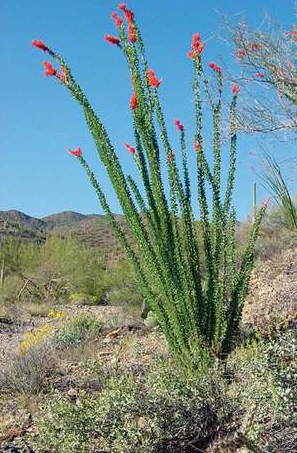obedient plant n. a North American herb (Physostegia virginiana (L.) Benth., of the Lamiaceae) bearing an apical raceme of white or pink opposite flowers. Its floral pedicels allow flowers to be placed at specific angles and remain in position.
ob·lan·ce·o·late (ob lan´sē ō´lāt or ob lan´sē ə lāt) adj. of a leaf blade, having a narrow rounded apex and extended tapering base. [< L ob- inverted + LL lanceolātus lance-like]
ob·late (ob´lāt´) adj. of a spheroid, or of bodies resembling a spheroid, having the equatorial diameter being greater than the polar diameter. [NL oblatus, on the pattern of prolatus]
ob·trul·late (äb´trul´āt) adj. of leaf blades, having a quadrangular outline acute at base and tip, and with angled margins just distal to the midpoint. [< L ob- against, facing + trulla trowel + -ātus provided with]
o·ca (ō´kə) n. 1 a cultivated herb native to the mountains of Chile, Peru and Bolivia (Oxalis tuberosa Molina, of the Oxalidaceae), bearing oblong rhizomatous tubers. 2 the edible tuber of this plant. [< Sp. < Quechua oqa]
ochre moss n. in the novel A Princess of Mars by Edgar Rice Burroughs, a moss – ochre in colour – native to Barsoom (Mars), and which grows in ancient sea beds providing forage for draught animals.
o·co·ti·llo (ō´kə tē´lyō) n. a shrub native to southwestern North America (Fouquieria splendens Engelm. in Wisl., of the Fouquieriaceae), which bears spines, and bright clusters of scarlet flowers at its branch tips. [< Sp. dim. < Nahuatl ocotl torch]
old man’s beard n. 1 a woody climber native to southern Europe (Clematis vitalba L., of the Ranunculaceae); travellers’ joy. Its ripe achenes each bear a silky white plumule, suggesting the name. 2 any of numerous species of the lichen genus Usnea Dill. ex Adans. (of divisio Ascomycota familia Parmeliaceae), fruticose lichens growing as elongated strands hanging from tree branches, and often resembling hair; beard moss. 3 a shrub or small tree of southeastern North America (Chionanthus virginicus L., of the Oleaceae), whose inflorescences consist of a panicle of fragrant blossoms with narrow oblong white petals; fringe-tree.
ol·i·go·car·pous (ol´i gō kär´pəs) adj. of a flower, fruit, or taxon, consisting of or characterised by possessing few carpels. [NL < Gk. oligos ὀλίγος few, small + karpos καρπος fruit + L -ōsus prone to] —ol´i·go·car´py, n.
ol·i·go·ste·mo·nous (ol´i gō ste´mə nəs) adj. of a flower, producing few stamens. [< Gk. oligos ὀλίγος few, small + stemōn στήμων thread, stamen + L -ōsus pertaining to, prone to]
o·lim (ō´lēm) adv. once, formerly, used in nomenclature shorthand to indicate a previous location of a specimen. [L olim once, formerly]
o·pen (ō´pən) adj. 1 having ample spaces between elements: an open inflorescence. 2 of vascular bundles, containing active cambial tissue in the mature state. [< OE < Gmc.]
or·ache (ôr´əch) n. any annual herb of the genus Atriplex L. (of the Chenopodiaceae), ruderals of arable or waste land whose leaves may be harvested for food. The fruit of female flowers is borne within a pair of enlarged bracts. [< ME orage, arage < OF arache < L atriplex < Gk. atráphaxus ἀτράφαξυς]
or·ang·e·ry (ôr´inj ə rē) n. -ries. a garden or construction, akin to a greenhouse, within which orange trees can be or are cultivated. [< F orangerie, a garden established at the Palais de la Louvre in 1617 < F orange orange + -erie (< L -eria qualities collectively, and/or a place where something is raised or grows)]
Or·do·vi·ci·an (ôr´dō vē´shē ən) adj. in geology, of or pertaining to a period of the Palæozoic era, 505 to 430 million years ago, characterised by the dominance of fishes and the advent of liverworts and fern-like trees. —n. in geology: a the period of the Palæozoic era coming between the Cambrian and the Silurian. b the rocks formed during this period. [< L Ordovices ancient Celtic tribe of north Wales, where rock of this age occurs + -an provenance]
or·ris (ôr´is) n. the prepared rootstock of Iris ×florentina L. (of the Iridaceae), for use in perfumery and natural medicine. [unexplained mispronunciation of ‘iris’]
or·thos·ti·chy (ôr´thos´ti kē) n. -chies (-kēz). 1 in phyllotaxis, an arrangement of leaves (or branches) vertically one above another, so that their medial planes coincide. 2 a single set of leaves so aligned. [< NL < Gk. orthos ὀρθός straight + stichia στίχια alignment] —or´thos´ti·chous, adj.
oud (üd) n. agarwood. [< Ar. al-´üd]
out·grow (out grō´) v.t. out·grew, out·grown, out·grow·ing. 1 grow more quickly or taller than (another). 2 grow too large for (a physical or conceptual space).
out·growth (out´grōth) n. 1 a natural growth of distinctive tissue or an organ upon the exterior of a pre-existing vegetative body; enation. 2 the process of executing outward growth. 3 the result or consequence of some given condition, or of a conflation of causative factors.
o·ver·hang (ō´vər hang´ (n.), ō´vər hang´ (v.t.)) n. v.t. o·ver·hung, o·ver·hang·ing. —n. 1 a process or accumulation of various tissues which project laterally over another individual of lower stature. 2 the area or density of such projecting tissue. —v.t. of a plant, bear leaves, branches, or other processes, which project laterally above another individual of lower stature.
o·ver·shoot (ō´vər shüt´) n. v.t. o·ver·shot (ō´vər shät´), o·ver·shoot·ing (ō´vər shü´ting). —n. 1 existence in a temporary state of having overused required resources, of being beyond the sustainable capacity of the environment. 2 the state of overuse of required resources. —v.t. go beyond the sustainable capacity of the ambient environment in some definable fashion, usually through growth.
o·ver·sto·rey (ō´vər stō´rē) n. the uppermost canopy layer of a forest community, that formed by the foliage and branches of the tallest trees and their epiphytes; canopy.
ox- comb.form., prefix. in names of plants, denotes coarse or large species, or else those eaten by – or fit for – oxen.
ox-harrow n. a large, powerful harrow which can be used in clay lands, and originally pulled by oxen. —v.t. cultivate (a field) using an ox-harrow.

